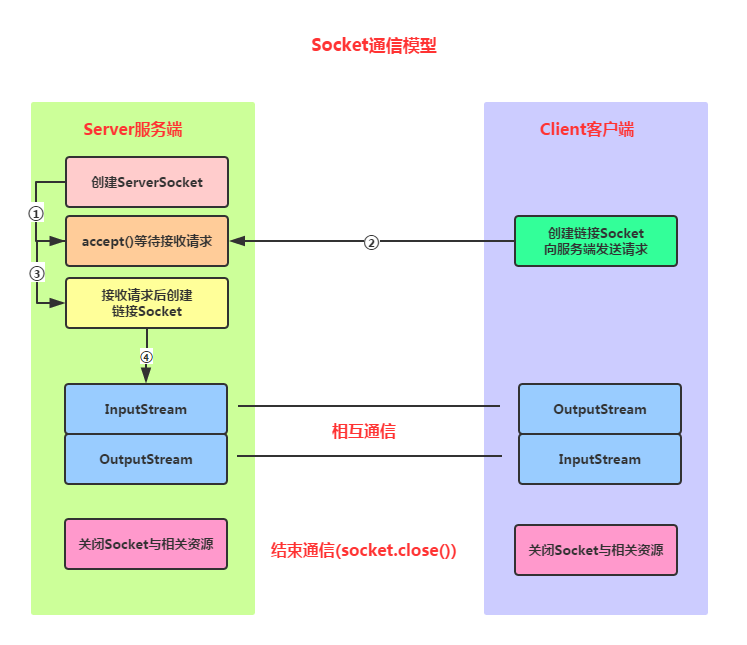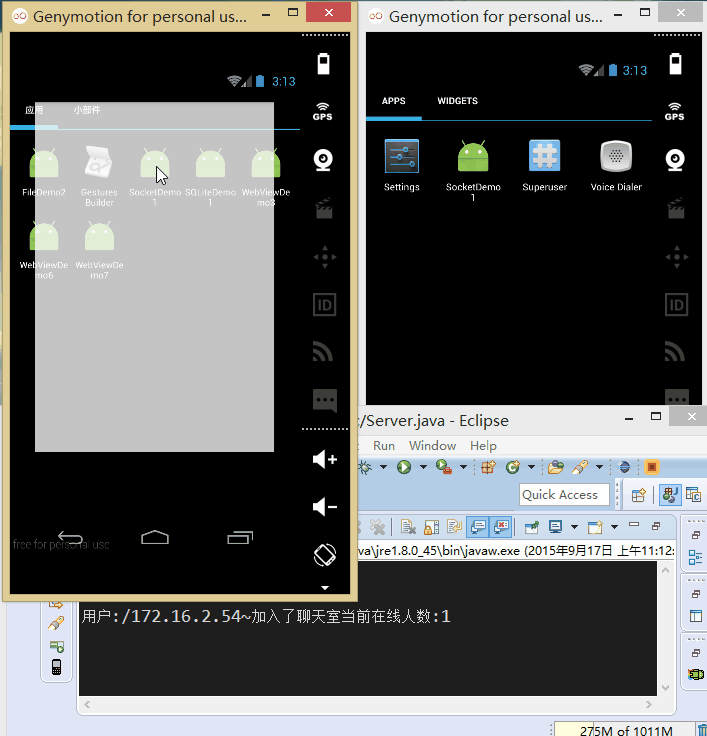本节引言:
1.什么是Socket?

2.Socket通信模型:

Socket通信实现步骤解析:
好的,我们接下来写一个简单的例子,开启服务端后,客户端点击按钮然后链接服务端, 并向服务端发送一串字符串,表示通过Socket链接上服务器~
3.Socket服务端的编写:
服务端要做的事有这些:
代码实现:
直接在Eclipse下创建一个Java项目,然后把Java代码贴进去即可!
public class SocketServer {
public static void main(String[] args) throws IOException {
//1.创建一个服务器端Socket,即ServerSocket,指定绑定的端口,并监听此端口
ServerSocket serverSocket = new ServerSocket(12345);
InetAddress address = InetAddress.getLocalHost();
String ip = address.getHostAddress();
Socket socket = null;
//2.调用accept()等待客户端连接
System.out.println("~~~服务端已就绪,等待客户端接入~,服务端ip地址: " + ip);
socket = serverSocket.accept();
//3.连接后获取输入流,读取客户端信息
InputStream is=null;
InputStreamReader isr=null;
BufferedReader br=null;
OutputStream os=null;
PrintWriter pw=null;
is = socket.getInputStream(); //获取输入流
isr = new InputStreamReader(is,"UTF-8");
br = new BufferedReader(isr);
String info = null;
while((info=br.readLine())!=null){//循环读取客户端的信息
System.out.println("客户端发送过来的信息" + info);
}
socket.shutdownInput();//关闭输入流
socket.close();
}
}
然后我们把代码run起来,控制台会打印:

好的,接下来到Android客户端了!
4.Socket客户端的编写:
客户端要做的事有这些:
代码实现:
MainActivity.java:
public class MainActivity extends AppCompatActivity implements View.OnClickListener {
@Override
protected void onCreate(Bundle savedInstanceState) {
super.onCreate(savedInstanceState);
setContentView(R.layout.activity_main);
Button btn_accept = (Button) findViewById(R.id.btn_accept);
btn_accept.setOnClickListener(this);
}
@Override
public void onClick(View v) {
new Thread() {
@Override
public void run() {
try {
acceptServer();
} catch (IOException e) {
e.printStackTrace();
}
}
}.start();
}
private void acceptServer() throws IOException {
//1.创建客户端Socket,指定服务器地址和端口
Socket socket = new Socket("172.16.2.54", 12345);
//2.获取输出流,向服务器端发送信息
OutputStream os = socket.getOutputStream();//字节输出流
PrintWriter pw = new PrintWriter(os);//将输出流包装为打印流
//获取客户端的IP地址
InetAddress address = InetAddress.getLocalHost();
String ip = address.getHostAddress();
pw.write("客户端:~" + ip + "~ 接入服务器!!");
pw.flush();
socket.shutdownOutput();//关闭输出流
socket.close();
}
}
因为Android不允许在主线程(UI线程)中做网络操作,所以这里需要我们自己 另开一个线程来连接Socket!
运行结果:
点击按钮后,服务端控制台打印:

5.增强版案例:小猪简易聊天室
实现的效果图:
先把我们的服务端跑起来:

接着把我们的程序分别跑到两台模拟器上:

接下来我们来写代码:
首先是服务端,就是将读写socket的操作放到自定义线程当中,创建ServerSocket后,循环 调用accept方法,当有新客户端接入,将socket加入集合当中,同时在线程池新建一个线程!
另外,在读取信息的方法中,对输入字符串进行判断,如果为bye字符串,将socket从集合中 移除,然后close掉!
Server.java:
public class Server {
//定义相关的参数,端口,存储Socket连接的集合,ServerSocket对象
//以及线程池
private static final int PORT = 12345;
private List<Socket> mList = new ArrayList<Socket>();
private ServerSocket server = null;
private ExecutorService myExecutorService = null;
public static void main(String[] args) {
new Server();
}
public Server()
{
try
{
server = new ServerSocket(PORT);
//创建线程池
myExecutorService = Executors.newCachedThreadPool();
System.out.println("服务端运行中...\n");
Socket client = null;
while(true)
{
client = server.accept();
mList.add(client);
myExecutorService.execute(new Service(client));
}
}catch(Exception e){e.printStackTrace();}
}
class Service implements Runnable
{
private Socket socket;
private BufferedReader in = null;
private String msg = "";
public Service(Socket socket) {
this.socket = socket;
try
{
in = new BufferedReader(new InputStreamReader(socket.getInputStream()));
msg = "用户:" +this.socket.getInetAddress() + "~加入了聊天室"
+"当前在线人数:" +mList.size();
this.sendmsg();
}catch(IOException e){e.printStackTrace();}
}
@Override
public void run() {
try{
while(true)
{
if((msg = in.readLine()) != null)
{
if(msg.equals("bye"))
{
System.out.println("~~~~~~~~~~~~~");
mList.remove(socket);
in.close();
msg = "用户:" + socket.getInetAddress()
+ "退出:" +"当前在线人数:"+mList.size();
socket.close();
this.sendmsg();
break;
}else{
msg = socket.getInetAddress() + " 说: " + msg;
this.sendmsg();
}
}
}
}catch(Exception e){e.printStackTrace();}
}
//为连接上服务端的每个客户端发送信息
public void sendmsg()
{
System.out.println(msg);
int num = mList.size();
for(int index = 0;index < num;index++)
{
Socket mSocket = mList.get(index);
PrintWriter pout = null;
try {
pout = new PrintWriter(new BufferedWriter(
new OutputStreamWriter(mSocket.getOutputStream(),"UTF-8")),true);
pout.println(msg);
}catch (IOException e) {e.printStackTrace();}
}
}
}
}
接着到客户端,客户端的难点在于要另外开辟线程的问题,因为Android不允许直接在 主线程中做网络操作,而且不允许在主线程外的线程操作UI,这里的做法是自己新建 一个线程,以及通过Hanlder来更新UI,实际开发不建议直接这样做!!!
布局文件:activity_main.xml:
<LinearLayout xmlns:android="http://schemas.android.com/apk/res/android"
android:layout_width="match_parent"
android:layout_height="match_parent"
android:orientation="vertical" >
<TextView
android:layout_width="wrap_content"
android:layout_height="wrap_content"
android:text="小猪简易聊天室" />
<TextView
android:id="@+id/txtshow"
android:layout_width="match_parent"
android:layout_height="wrap_content"
/>
<EditText
android:id="@+id/editsend"
android:layout_width="match_parent"
android:layout_height="wrap_content"
/>
<Button
android:id="@+id/btnsend"
android:layout_width="match_parent"
android:layout_height="wrap_content"
android:text="发送"
/>
</LinearLayout>
MainActivity.java:
public class MainActivity extends AppCompatActivity implements Runnable {
//定义相关变量,完成初始化
private TextView txtshow;
private EditText editsend;
private Button btnsend;
private static final String HOST = "172.16.2.54";
private static final int PORT = 12345;
private Socket socket = null;
private BufferedReader in = null;
private PrintWriter out = null;
private String content = "";
private StringBuilder sb = null;
//定义一个handler对象,用来刷新界面
public Handler handler = new Handler() {
public void handleMessage(Message msg) {
if (msg.what == 0x123) {
sb.append(content);
txtshow.setText(sb.toString());
}
}
;
};
@Override
protected void onCreate(Bundle savedInstanceState) {
super.onCreate(savedInstanceState);
setContentView(R.layout.activity_main);
sb = new StringBuilder();
txtshow = (TextView) findViewById(R.id.txtshow);
editsend = (EditText) findViewById(R.id.editsend);
btnsend = (Button) findViewById(R.id.btnsend);
//当程序一开始运行的时候就实例化Socket对象,与服务端进行连接,获取输入输出流
//因为4.0以后不能再主线程中进行网络操作,所以需要另外开辟一个线程
new Thread() {
public void run() {
try {
socket = new Socket(HOST, PORT);
in = new BufferedReader(new InputStreamReader(socket.getInputStream(), "UTF-8"));
out = new PrintWriter(new BufferedWriter(new OutputStreamWriter(
socket.getOutputStream())), true);
} catch (IOException e) {
e.printStackTrace();
}
}
}.start();
//为发送按钮设置点击事件
btnsend.setOnClickListener(new View.OnClickListener() {
@Override
public void onClick(View v) {
String msg = editsend.getText().toString();
if (socket.isConnected()) {
if (!socket.isOutputShutdown()) {
out.println(msg);
}
}
}
});
new Thread(MainActivity.this).start();
}
//重写run方法,在该方法中输入流的读取
@Override
public void run() {
try {
while (true) {
if (socket.isConnected()) {
if (!socket.isInputShutdown()) {
if ((content = in.readLine()) != null) {
content += "\n";
handler.sendEmptyMessage(0x123);
}
}
}
}
} catch (Exception e) {
e.printStackTrace();
}
}
}




